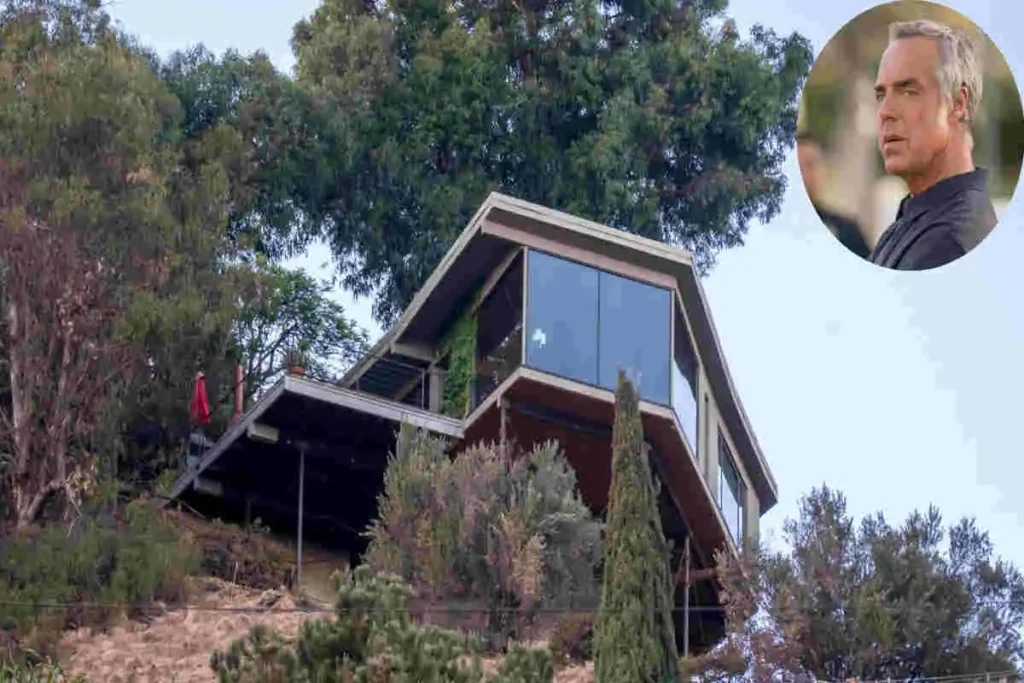The character Harry Bosch might not be as ordinary as the rest of fictional characters. Written by the famous Michael Connelly, Bosch has been an integral part of Connelly’s novels as well as the television series Bosch. His relentless pursuit for justice mandates contradiction for his character. But what truly adds to his intrigue is not just his work – it is his modern home.
| Specification | Details |
|---|---|
| Address (TV Series) | 1870 Blue Heights Drive, Hollywood Hills West, Los Angeles, California |
| Address (Novels) | Woodrow Wilson Drive, Hollywood Hills. Specific addresses vary in novels, e.g., near 7203 or 8620 Woodrow Wilson Drive |
| Number of Bedrooms | 2 |
| Number of Bathrooms | 2 |
| Square Footage | Approximately 1,500 to 2,000 square feet |
| Worth (TV House) | Estimated at $2,130,000. |
| Architectural Features | Modern design with wood and glass, open floor plan, large windows for natural light |
| Notable Features | Spacious living room with artworks, integrated kitchen and dining area, minimalist bedroom, small office space, serene backyard garden |
The residence of Bosch is a portrayal of a person he is. Situation on the Hollywood Hills where he has a breathtaking view of Los Angeles, the house is a bold blend of intimacy. It sways between artistic and functional in a novel manner that reveals Bosch’s lifestyle and personality. Theanda is amazing, architects and interior design enthusiasts would agree that studying Harry Bosch’s house features is more than just revising the floor plan, it helps one fathom the character.
Summary of Harry Bosch’s House

Address and History
Placed in the Hollywood Hills, the house of Harry Bosch is very conveniently situated. It offers Bosch a breathtaking view of the Los Angeles skyline as the city is placed under the elevated house. This view of the city serves as the constant backdrop to Bosch’s moments of intense introspection. The location holds more than just geographic significance; it symbolizes Bosch’s internal perpetual conflict as he is placed above the chaos of the city while deeply connected to it.
Also interesting is the fact that there is a real-life house which seems to exist only in fiction. The abode that was used for filming the series is at 1870 Blue Heights Drive. This modern architectural wonder reflects the very essence of Bosch’s character. The mid-centuary modern structure was chosen for its beautiful rugged elegance which embodies the protagonist.
Where does Harry Bosch currently live?
Harry Bosch currently lives in a cantilevered house located at 1870 Blue Heights Drive in Hollywood Hills West, Los Angeles, California. The house is a modern architectural design perched high atop a hill with views overlooking the Sunset Strip and Culver City. This location is prominently featured in the Bosch TV series and reflects Bosch’s character and lifestyle. The house was originally depicted as his luxury home in both the novels and the television adaptation, and it was financed by earnings from a high-profile case. The residence is known for its unique structure, wooden and glass design, and hilltop position supported by steel pylons.
Architectural Style
The Modern and functional styles are both evident in the architecture of Harry Bosch’s House. Its aerial view shows that it is canted and rests on the hillside. This look gives the structure a feeling of gravity defiance as it gently touches the earth while the sky embraces it.
The house’s materials include wood and glass. This means the house possesses warmth while also being welcoming. The use of glass guarantees that the house has uninterrupted sunlight during the day, while the wooden parts add a sense of comfort. This combination of materials captures Bosch’s duality, being as strong and stoic as an oak, yet as an introspective warm as the ring inside.
Floor Plan Breakdown
Analysis of the floor plan helps to showcase the sharp attention to detail Harry Bosch posses. Every space is designed considering functionality, but most importantly, serving to portray Bosch’s character. In the following, I will highlight the important parts of the house facts.
Living Room
Bosch’s house is centered around the living room. His eyes must be drawn to the views of Los Angeles as the room is designed to maximize them with spacious floor-to-ceiling glass windows. Additionally, the inviting and serene atmosphere offered by the light flooding the space soothes both Bosch’s heart and mind.
The decor captures the essence of Bosch’s life with artwork and personal items. Notably, one cannot miss the subtle nods to his career as a detective case in the form of paintings or some artifacts. More than just a spot to unwind, the living room functions as a retreat where Bosch contemplates his work and life.
Kitchen and Dining Area
The kitchen and dining space follows an open-concept design that merges warmth and practicality seamlessly. The kitchen offers modern appliances and is, therefore, practical. On the other hand, rustic wooden cabinetry and a simple dining table provide character.
Bosch’s no-frills personality is most prominent here. The unassuming design and remarkable functionality is ideal for his comfort and needs. The modesty of the dining area transforms house it into a delightful spot to enjoy a peaceful meal while admiring the view.
Bedroom
Bosch’s private sanctuary is a reflection of his minimalist lifestyle. The large windows not only frame serene views of the Hollywood Hills but also turns the bedroom into a retreat. The dark tones and simple furnishings help the space exude a no nonsense vibe. The bedroom is not just a place for Bosch to get some rest, but a reflection area for quiet moments of contemplation.
Office Space
Set up for an optimized flow of focus, Bosch’s small and functional office outdoor space is filled with books, case files, and notebooks. The lack of distractions make this workspace ideal. Bosch spends countless hours in this office piecing together clues and solving cases, so the excess storage for all of his investigative materials is just a bonus.
Bathrooms
The house features two bathrooms, one of which is likely part of a master suite. Even if there is no detailed information about the bathrooms, they most likely reflect a blend of modernity and functionality while retaining the essence of the design throughout the house.
Distinctive Characteristics of the House
Cantilevered Structure
The most visually striking feature of Harry Bosch’s house is it’s cantilevered formation. The house is placed on a hillside which offers unrivalled views of Los Angeles. This aesthetic shift, allows for better contemplation of views which is in accordance to the home nature of Bosch’s character. It also heightens modernist approach towards architecture.
| Specification | Details |
|---|---|
| Address (TV Series) | 1870 Blue Heights Drive, Hollywood Hills West, Los Angeles, California |
| Address (Novels) | Woodrow Wilson Drive, Hollywood Hills, Los Angeles, California. Specific addresses vary in different novels, such as next to 7203 or 8620 Woodrow Wilson Drive |
| Architectural Style | Modern, featuring wood and glass, with a cantilevered design |
| Year Built | The house used in the TV series was built in 1958 |
| Floor Plan | Open-concept layout with large windows, integrating kitchen and dining areas. It includes a living room, kitchen, dining area, 2 bedrooms, and 2 bathrooms |
| Size | Approximately 1,513 square feet of living space on a 0.26-acre lot |
| Worth | Estimated to be around $2,130,000 according to Zillow |
| History | In the novels, the house is described as overlooking the Hollywood Freeway. In the TV series, it is depicted as a key part of Harry Bosch’s life, offering panoramic views of Los Angeles |
| Affordability | In the storyline, Harry Bosch affords the house due to a movie deal based on one of his cases |
Large Glass Windows
The multitude of glass windows located all over the house, connects the home design with nature which greatly improves it’s beautu. These open the insides of the house to natural sunlight and views of the city. The city that he so often reflects himself upon, is captured by the windows, adding sympathy to their structure which is representative of Bosch’s nature.
Backyard Garden
The beauty of the house and, can easily be admired, however for Bosch, the backyard garden provides a quiet subtle place to flee towards. It is simple in form and adds elegance while promoting tranquility to it’s surroundings. This garden is a wonderful escape for those longing solitude within chaos of urban life.
Symbolism of the Floor Plan

Every single room within Harry Bosch’s house was built thinking about him, almost every feature encapulates a small portion of Bosch character. He:
- Living Room: This space windows is devoted to people in deep thoughts so it also serves as a place to bond while offering retreat allowing retreat in combining love and relief, symbolizing Bosch’s inner sense of anguish and longing for connection.
- Bedroom: A place where his love for simplicity and peace is beautifully highlighted.
- Office: A delineation of his unyielding fight for justice and commitment to his profession.
Real-Life Inspiration
The real-life house that was used for the series is a stunning mid-century modern design, estimated at around $2.13 million. This house’s design and architecture closely aligns to Michael Connelly’s novels, making it the ideal choice for Bosch’s house in the series. The historical significance of the house along with its current worth enhances its beauty and serves as an ideal house for admirers of the architecture.
Why Fans Love Harry Bosch’s House
Bosch enthusiasts are attached to the house since it seems like an embodiment of Bosch himself. It is not merely a set piece for the series; it functions as a building block of the narrative. The house is a retreat for Bosch, enabling him to reflect, recharge, and reconnect.
Interior Design Insights
Design Principles
The house exquisitely combines a work of art and a functional piece. The architecture is modernist, however more personal touches that make the house feel lived-in were added.
Takeaways
- Add more windows to your house to allow an influx of sunlight to illuminate your stylish home.
- Combine rustic and modern styles to enhance warmth while maintaining functionality and design.
- As seen above, integrate the plot elements of the fiction book into design details that relate to you.
Harry Bosch House FAQs
Based on the popular Bosch TV series and Michael Connelly’s novels, Harry Bosch’s iconic house is a key element of the story, often depicted as a modernist home with stunning views. Below are some frequently asked questions about it, drawn from available details.
Where is Harry Bosch’s house located in the TV series?
In the Amazon TV series Bosch, Harry Bosch’s house is portrayed as 1870 Blue Heights Drive in the Hollywood Hills West area of Los Angeles. This location offers breathtaking views of L.A. through its glass walls and is an architectural standout. For the best real-world views of the actual house used in filming, check the 1600 block of Viewmont Drive or the 8800 block of Hollywood Boulevard.
Is the house address the same in the books?
No, the book’s place is Bosch’s home Woodrow Wilson Drive in the Hollywood Hills, California. For example, in the 2010 novel The Reversal, it’s situated beside 7203 Woodrow Wilson, and in the 2018 novel Dark Sacred Night, it’s at 8620 Woodrow Wilson.
Is Harry Bosch’s house a real location, and can you visit it?
Yes, the house used in the TV series is a real property at 1870 Blue Heights Drive, Los Angeles, CA 90069, though it’s a private residence not open to the public. Fans should avoid clogging the narrow residential streets in the area, as locals in the Hollywood Hills (sometimes called “the squiggles”) dislike lookie-loos. It’s not been on the market recently, so public house access is limited.
What makes the house special in the series?
The house is depicted as a stunning architectural wonder with glass walls providing panoramic views of Los Angeles, fitting Bosch’s character as a place where he unwinds by playing jazz records. It’s a symbol of his success and solitude in the Hollywood Hills.
Are there any quirky or real-life issues with the house shown in the show?
In one episode, a scene shows ants crawling on the wall in Bosch’s kitchen during a conversation with Eleanor, highlighting that even a million-dollar home in the Hollywood Hills isn’t immune to pests like ants or termites, which are common in the area.
What’s the difference between Bosch’s house and his apartment?
The house is his primary residence in the series, but Bosch also had a swanky apartment that was notably absent in Bosch: Legacy Season 1 for specific storyline reasons. The house remains the more iconic setting.
For more on the Bosch universe, including spin-offs like Ballard, which home feature crossovers with Bosch, the series continues to expand with new seasons and casts. If you have a specific question about the show or books, feel free to ask!

